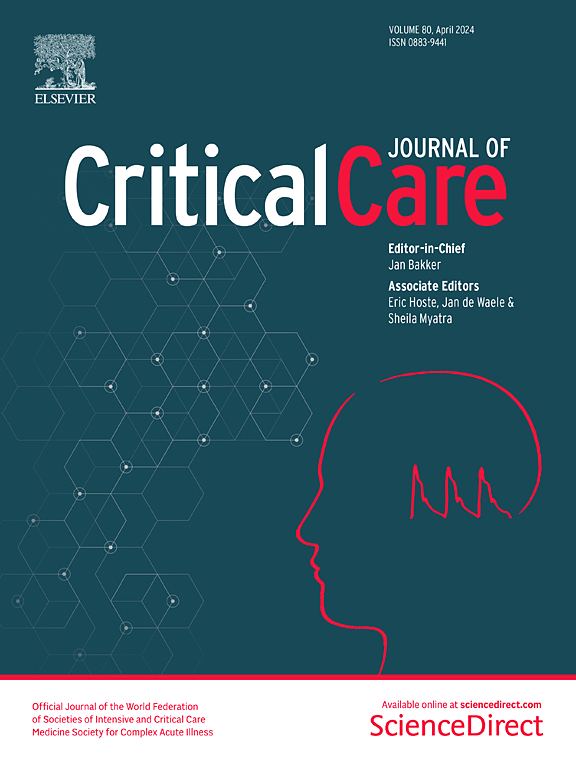在有和没有重症监护病房的医院中入住中级监护病房的病人的住院死亡率:一项全国住院病人数据库研究
IF 8.8
1区 医学
Q1 CRITICAL CARE MEDICINE
引用次数: 0
摘要
中级监护病房(imcu)为需要比普通病房更深入治疗但比重症监护病房(icu)更深入治疗的患者提供护理。虽然IMCU的概念需要与ICU合设,但有些医院有IMCU但没有ICU,这可能会使患者的预后恶化。本研究旨在检查年度趋势和护理过程,并使用日本全国住院患者数据库比较有icu和没有icu的医院入住imcu患者的结果。本回顾性队列研究于2016年至2022年在日本使用诊断程序组合数据库和医院病床功能报告进行。主要暴露是在有icu和没有icu的医院入住IMCU。主要终点是有icu和没有icu的医院的住院死亡率,使用校正混杂因素的多水平逻辑回归模型进行比较。无icu医院的IMCU床位从2016年的3388张增加到2022年的5403张,增加了59%,无icu医院的IMCU床位占2022年日本所有IMCU床位的38% (n = 5403 / 14185)。在3,061,960名符合条件的imcu患者中,分别有2,296,939名(75%)和765,021名(25%)入住有icu和没有icu的医院。10.5%的患者(n = 320,938/3,061,960)发生了imcu和icu之间的转移,医院之间的差异很大。在对潜在混杂因素进行校正后,在没有icu的医院入住imcu的患者的住院死亡率显著高于有icu的医院(校正优势比:1.15;95%置信区间:1.10-1.20;p < 0.001)。在没有icu的医院,重症监护病房的入院率增加,但与较高的住院死亡率相关。这些结果提示,icu应放置在有icu的医院。本文章由计算机程序翻译,如有差异,请以英文原文为准。
In-hospital mortality of patients admitted to the intermediate care unit in hospitals with and without an intensive care unit: a nationwide inpatient database study
Intermediate care units (IMCUs) provide care for patients who need more intensive treatment than general wards but less than intensive care units (ICUs). Although the concept of an IMCU requires co-location with an ICU, some hospitals have IMCUs but no ICUs, which potentially worsens patient outcomes. This study aimed to examine the annual trends and care processes, and compare the outcomes of patients admitted to IMCUs in hospitals with and without ICUs using a nationwide inpatient database in Japan. This retrospective cohort study was conducted from 2016 to 2022 using the Diagnosis Procedure Combination Database and Hospital Bed Function Reports in Japan. The main exposure was admission to the IMCU in hospitals with and without ICUs. The primary outcome was in-hospital mortality rate in hospitals with and without ICUs that were compared using multilevel logistic regression models adjusted for confounders. The number of IMCU beds in hospitals without ICUs increased by 59% from 3,388 in 2016 to 5,403 in 2022, and the IMCU beds in hospitals without ICUs represented 38% (n = 5,403/14,185) of all IMCU beds in Japan in 2022. Among the 3,061,960 eligible patients in the IMCUs, 2,296,939 (75%) and 765,021 (25%) were admitted to hospitals with and without ICUs, respectively. Transfer between IMCUs and ICUs occurred for 10.5% (n = 320,938/3,061,960) of patients, with a large variability between hospitals. After adjusting for potential confounders, patients admitted to IMCUs in hospitals without ICUs had significantly higher in-hospital mortality than those in hospitals with ICUs (adjusted odds ratio: 1.15; 95% confidence interval: 1.10–1.20; p < 0.001). Admission in IMCUs in hospitals without ICUs increased, but was associated with higher in-hospital mortality. These findings suggest that IMCUs should be placed in hospitals with ICUs.
求助全文
通过发布文献求助,成功后即可免费获取论文全文。
去求助
来源期刊

Critical Care
医学-危重病医学
CiteScore
20.60
自引率
3.30%
发文量
348
审稿时长
1.5 months
期刊介绍:
Critical Care is an esteemed international medical journal that undergoes a rigorous peer-review process to maintain its high quality standards. Its primary objective is to enhance the healthcare services offered to critically ill patients. To achieve this, the journal focuses on gathering, exchanging, disseminating, and endorsing evidence-based information that is highly relevant to intensivists. By doing so, Critical Care seeks to provide a thorough and inclusive examination of the intensive care field.
 求助内容:
求助内容: 应助结果提醒方式:
应助结果提醒方式:


